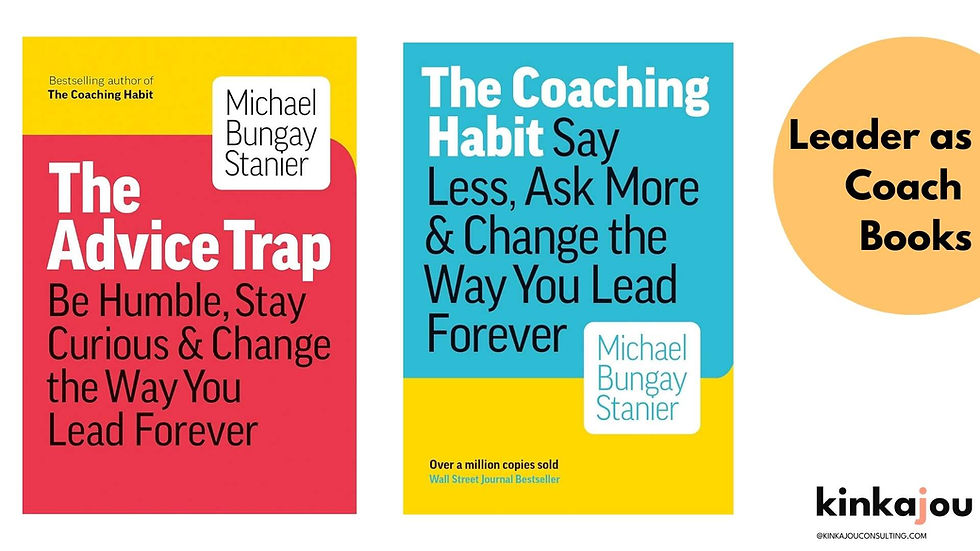The Coaching Habit Questions Summary
- Fern Beauchamp

- Jul 15
- 4 min read
Updated: Sep 12
Employees who feel heard are 4.6 times more likely to feel empowered to perform their best work - Salesforce.com
If you’re a leader, you’ve probably felt the pressure to have all the answers.
But guess what...you don't!
The magic sauce is the ability to ask great questions.
This does not mean asking questions to show how smart you are and trip up your team. It's about asking questions that demonstrate genuine curiosity about their perspectives. When managers shift from "telling" to "asking," you empower teams and avoid burning yourself out.
But how do you do that? This article summarises one of our go-to resources to help leaders - Michael Bungay Stanier's questions from The Coaching Habit book, as well as his Advice Monster concept.
Contents
Why Leaders Should Ask, Not Tell
Leadership is less about having all the answers and more about asking the right questions – of others and of ourselves. Leaders who ask questions encourage their teams to think critically, problem-solve, and take ownership. This approach not only sparks innovation and growth but also builds a culture where everyone feels valued and heard.
And the impact is real. Research shows that a coaching leadership style, which emphasises asking questions and active listening, has a direct and significant positive impact on employee engagement and performance.
"coaching leadership has a direct and significant positive impact on employee engagement" (Tang et al., 2024, p.10).
Empowered teams are more likely to do their best work and be engaged.
And highly engaged teams can see 78% lower absenteeism, according to Gallup.
So, how do you put this "ask, don’t tell" approach into practice? This is where a little structure – and the right set of questions – can help.
Leader as Coach Book Recommendations
Two standout books, The Coaching Habit and The Advice Trap, both by Michael Bungay Stanier, offer practical frameworks to help leaders and managers shift from advice-giving to curiosity-driven coaching. Let’s take a closer look at what these books offer and how their questions can transform your leadership conversations.

The Coaching Habit by Michael Bungay Stanier is a practical guide for leaders who want to make coaching-style leadership a daily habit. The book’s core message is simple: Leadershio isn’t about having all the answers – it’s about asking the right questions, listening more, and talking less.
Stanier introduces seven essential questions that help leaders cut through the noise, get to the heart of issues, and empower their teams to find their solutions.
The Advice Trap, also by Stanier, is the follow-up to The Coaching Habit. While the first book teaches you what to ask, The Advice Trap digs into why it’s so hard to resist giving advice – and why it’s worth the effort to hold back. The book challenges leaders to stay curious longer and tame their "Advice Monster". By doing so, leaders help their teams grow, become more self-reliant, and ultimately achieve better results.
📚 Check out our 25 Must-Read Leadership Books 2025 for more recommended reading.
The Coaching Habit: 7 Essential Questions
Michael Bungay Stanier’s The Coaching Habit lays out seven simple, powerful questions that every leader can use to spark collaborative conversations with their teams:
The Kickstart Question
"What’s on your mind?"
Purpose: Opens the conversation and focuses on what matters most right now.
How it empowers: Gives your team member the space to set the agenda and share what’s important to them.
The AWE Question
"And what else?"
Purpose: Encourages deeper thinking and uncovers more options or insights.
How it empowers: Shows you’re genuinely interested and helps your team member explore beyond their first response.
The Focus Question
"What’s the real challenge here for you?"
Purpose: Helps pinpoint the core issue, not just the surface problem.
How it empowers: Encourages ownership and self-reflection, leading to more meaningful solutions.
The Foundation Question
"What do you want?"
Purpose: Clarifies needs, motivations, and desired outcomes.
How it empowers: Helps your team member articulate their goals and take responsibility for their next steps.
The Lazy Question
"How can I help?"
Purpose: Avoids assumptions and puts the team member in the driver’s seat.
How it empowers: It empowers them to ask for support in a way that’s actually useful.
The Strategic Question
"If you’re saying yes to this, what are you saying no to?"
Purpose: Encourages focus and prioritisation.
How it empowers: Prompts thoughtful decision-making and helps avoid overwhelm.
The Learning Question
"What was most useful for you?"
Purpose: Reinforces learning and reflection at the end of the conversation.
How it empowers: Encourages a growth mindset and helps both of you get better at coaching conversations.
Why These Questions Matter
They empower: Your team learns to think critically and solve problems independently.
They build trust: People feel heard and respected.
They save time: You spend less time firefighting and more time supporting growth.
They drive results: Engaged, empowered teams are more productive and innovative.
Simple Ways to Start
Start practising active listening – give your full attention.
Start using open-ended questions to spark deeper thinking.
Start noticing your Advice Monster.
Stop trying to have all the answers and leave space for others.
Final Thoughts
It's a myth that leaders need to have all the answers. By asking the right questions and listening deeply, you empower your team to find their solutions – and that’s where real growth and business success begin. Start with one or two of these questions in your next conversation, resist the urge to jump in with advice, and watch your team’s confidence and trust in you grow.
Interested in Leadership Development?
Check out our 1:1 leadership coaching, leadership group coaching, and leadership coaching for women or first-time managers services to enhance your leadership development journey.


